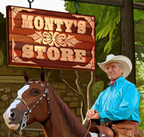Hi everyone ! The long lining lessons showed how easy it can be and how easy it is if you just do not think to much about having to handle theses two lines and maybe make a knot into them ! I love to long line and I guess I am quite good doing it BUT it is as a matter of fact very exhausting if you have a slow and difficult to move horse. As we just use our body / energy and the long lines to push a slowly horse. I have one of this type. He did quite well (just slow) the first two times ever I put the long lines on him. up from the third to the forth and fifth time he became difficult to move on his right hand and stopped and rolled into the lines. I worked without giving up and got him to understand how to turn and yield from the presure on his backside to roll out of the lines. But I it is still so difficult to get him to canter. I am thinking of using the stick with the plastic to move him forward, just like Monty did it in a show in MARBACH last year. He was working with a heavy kind of Tinker (as irish as mine who is an Irish Sport Horse :-) ) and he got him moving. This is also a suggestion to you, Monty's team if you are serching for older films about long lining. Is there someone else who has the same problem ? Cheers, VioBerlin
Rewards
Subscribe to Equus Online University and become a part of Monty's worldwide mission to leave the world a better place for horses and for people too.
Students automatically gain access to special rewards, such as exclusive discounts at the Monty Roberts Online Shop. Visit Monty Roberts Online Shop.




Hi Vio Berlin,
I don't have the experience with this, because I have to learn this longlining.
But what I was wondering, did you do Join-up with your horse and was it also difficult to get him into a canter?
Cheers, May.
Hi VioBerlin,
I had lots of issues with my horse - he used to always stop in the turns, and was so difficult to get moving. After I did my introductory course with Lynn Mitchell and my body positioning was better, and worked on getting my energy up things improved a bit, but then I still had trouble sometimes. What I've found helpful was working him in a dressage arena and doing more figure 8 style turns, and some smaller circles without turning him (ie bringing him in as if to make room for the turn but then just keeping him going the same direction) because before that he would anticipate the turn, and therefore the stop as well. Finally I would say we are doing much better, but this is now 3 months since my intro course. Also, another point is that make sure you give heaps of room to turn if he is in the round yard, so it is a smooth turn - I found he is less likely to stop if given plenty of room. Hope that helps.
Kind regards,
Ruth
Hi there everyone ,I too had trouble getting my Appi to walk out on long lines and did use the plastic bag to stimulate him,and when I got into better driving position,as in the one used by dominant horses,he picked up much better.Plus, as he developed his back muscles and got fitter,the more willing and happy he was to work. All the best!
I too have had trouble driving my horse away from me and around me. I think I'll try the plastic bag on a stick. I don't know if he has ever been long lined but he has been single lined lunged (not by me). Even though he knows single line lunging, it will still take some time for him to learn long lining?
Hi all,
to make the transition from single line lunging to longlining, you might need so stimulant at first. I used a buggywhip, without ever touching the horse, but raised it behind him after the turn. As soon as he understood what was asked of him, I put the whip in the middle of the pen and only picked it up, when needed. As a next step I used the outside line, the one that goes behind the hocks to drive him. Later I could start driving with the inner line. The same horse had a large pressurezone, so when I cam too close, he went into pressure and stopped. This was an issue only at the very beginning of our working together, he knows now and is happy to work on the longlines and so am I! The right distance can make a lot of difference when driving, you have to play with it to find what works for every particular horse. Hope this helps!
Miriam
Hi everyone and THANK YOU for your comments, I will try out all of your suggestions. Yes, HERO is also difficutlt to get cantering when doing a Join-Up. I might be to close to him because I want to push him and travel closer and closer to him. I will use the plastic on the stick to move him and I started in the meantime to train the turn just putting one line around his backside and put presure on it just like if he was in girth plus long lines. He has got plenty of time to figure out how to get out of that presure and - see he found out how to turn and walk on. I also think my driving position is not perfect at times which makes him stop and role into the lines. Well, I'll keep you informed about our progress. Thanks again for your advice ! VioBerlin
I just worked two days with a horse that hardly moves. I need two principles. The first is that I start with very low energy requiring only forward motion, whatever speed. Then after a while I ask a little more, if the the horse does not react I go immediatly to 100% of stimulation to avoid desensitization. The second priciple is motivation. I put two parallel bars on the ground where the horse has to pass. In that particular horse it worked very well.
VioBerlin
You bring up an interesting point about position when long lining or lunging a horse. If you get in the horses blind spot he will stop and try to turn to find you. If you move too far forward he will either stop or he will change directions. I know if I am not paying attention my horse will stop and look at me to say Are we done? I don't long line and I lunge my horse without a line on him that way he keeps his body in the correct position. I don't lunge him very much anymore but we do a lot of walking before any serious training
Cheers
Hi Rudi and Dennis, thank you for your ideas/comments. I have not been going back to the long lines yet. I keep working on the motivation, wanting Hero to WANT to trott and canter. We are on a good point now, I did the same thing, put two bars in the round pen and motivated Hero to trott in hand aside with me around and over the poles. First day I was outside, letting him do less distance the next session i was inside leading him more from the inside, doing less and preparing for driving. It worked out fine ! We even trottetd into and out of the round pen. It's ok just to run on a spot (or jump) to motivate him to trott, no stick with rope or stick with plastic etc. needed anymore ! The following session we both were lasy and super relaxed - did erverything walking but trained turns which worked out well too. I decided not to try to push HIM when I do not feel fit enough, he would realize it and I wouldn't be a great motivation. I wait some more time until I am fit agian after my flight and fall on the rips six weeks ago. I am convinced, I can motivate him then much better to trott and canter on the long lines. Cross your fingers for me and let me know if you have more ideas, experiences. THANK YOU ! Cheers, VioBerlin
http://www.myvideo.ch/watch/7378883/Sabrina_Cenda
VioBerlin, you may have a look on this video with a lot of ideas of metting bars on the ground. These are soft, I am using them often. You can also make a cross or a triangle, or use cones.
Great exercises Rudi - I really enjoyed watching this video. Thanks for posting. I had a clinic last weekend with a guy who has worked with Monty for 8 years, and he uses poles on the ground and cones all the time, and I found it to be really beneficial for my horse as it kept him thinking and he was much more relaxed. I'm going to work with the triangle and the corridor now too!
Rudi
Very interesting video. Do you know what the significance of the blue and yellow poles and the designs that they make? Also looking at that horse move reminded me of the post about collection. If you can get your horse to move like the one in the video your horse will have good collection. If a horse looks all bunched up some people think that the horse is collected. Horses that have collection are fluid and flexible, not bunched up or strung out.
Thanks for all your great suggestions.
Cheers
There is indeed an idea behind the colors. Blue and yellow are contrast colors for the horses. They are used to stimulate both parts of the brain (left and right). When they pass the different obstacles they look at them and concentrate on them, this ususally causes a better collection. The basic idea is from Michael Geitner, he is calling the method "Dual activation". He has been influenced a lot by Monty Roberts. His books are all in German.
Rudi
Thanks.I have often wondered why my horse reacted to the color blue and why does Monty use a blue tarp to teach the horse to trust him as its leader.
Cheers
Dennis and Rudi,
The research I have done indicates that horses do not distinguish between actual colors, there is no actual scientific proof.
But they do see in a way of shades, such as light and dark.
Example: if you bring a horse from their stall, semi-light into a dark hallway, quite dark they will respond.
They may lift their heads because they have to adjust their sight, which takes some time.
And the colors of poles or cones would not really make a difference, only in the light or darkness of them.
Having similar colors (or shades to the horse) that one would have at an arena helps the horse to become familiar and less likely to spook because his eyesight has become adjusted to these.
Perhaps you have heard of riders at an arena doing practise sessions, they do this ALSO to accustom the horse to the different shades of the jumps, poles, etc...
And using a light colored tarp would immulate the light color (sparkle) of water, thereby getting the horse ready for true water.
Monty also does this for sound and touch for the horse. Keep in mind horses cannot see their feet or their chests, therefore, the reason for desensitizing them to unfamiliar things under them.
You can find more information about Equine Eyesight from Cheryl Sutor. It really helps us to understand why horses react to their surroundings.
Ronda
I liked the Johnathan Fields demos on long reining;he drives his mare into an area marked out with four traffic cones,then asks for halt.The horse was interested as the work had a purpose.Then while in the corner he let the mare stand while he threw the reins over her back etc,then asked her to walk smartly on to the next goal area.Purpose is a good thing to keep in mind.I also like poles on the ground and L shapes to drive forwards through and to back through.
Dear Ronda
I don't know what literature you have read. From the point of view of physiology there is no doubt that horses can distinguish colors: (http://www.journalofvision.org/content/1/2/2)
Horses are dichromates (having two photopigments in the retina, humans have three), they see yellow and blue (and the mixture green), they cannot distinguish between red and green (this happens also in humans if a photopigment is absent). It is a very interesting subject. What kind of feeling the brain receives is another question...
Hi Rudi,
You will notice I made a new post on the eyesight of the horse.
If you go there you will find one of my sourses.
Ronda
That sure is an extensive site, Ronda! Lots of great info! :)
To tie in with Rudi's observation, I'm thinking that since her article on eyesight was written back in 1996, she didn't have the scientific information that has been gathered since then.
.
Just earlier this year, I read an article (in Swedish) on the subject, quoting recent scientific research. I remember it mainly because they had manipulated photos to illustrate how a horse perceives colors.
I don't have it so I can't quote or refer to it, but I do remember how they spoke of horses being dichromate, "living in a green-blue world", and also how their eyes are shaped to better perceive movement, even at a distance, and shades, and also how white (or bright) things appear much larger to them than it does to us.
.
It sure is a fascinating subject! I wonder if we can ever fully understand how other beings perceive things with their eyes and how their brains work with the information.
Isn't it great Kicki,
I think the thing that interested me about all of this research was not so much about the colors but the way they perceive things and how long it takes them to focus.
It has helped me to understand their reactions and therefore be more understanding.
You might remember in that article she mentions how a horse reacts when brought outside at night.
Having both binocular and monocular vision and not being able to use both at the same time, wow!!!!
I have seen this reaction and always thought they were spooked but really only taking the time to refocus.
There's lots more information I have found on this subject and I want as much as possible for my book.
I wish I could read Swedish and German, boy would that help.
It seems the more we know the less we really know and have to keep on learning.
I love the subject of the horse, everything about it and I want an all round picture.
How they move, why they react, and the list goes on!!!!
From a horse lover,
Ronda
Hi Ronda,
Maybe this is something you like to see as well.
Just copy it, it is English spoken.
http://www.horses.nl/videos/bekijken/891
Cheers, May.
Rudi Thanks for sharing the video link. I have a new to me 24 year old Arab "Hunter". He loves anything related to trail riding. He gets bored quickly with anything that is not.
This thread should prove helpful the next time we long line.Vio Berlin for starting it.
Hunter needs some long line work to strengthen his neck and back for collection at the trot. All those poles should help get him moving. The bag on a stick could be helpfulbut he could care less about them. Not much that stimulates him except tree lined trails.
Rudi, beautiful, soft & relaxed horse, it was a pleasure to watch, thank you.
I have also read that they don't see red, but do see blue & yellow.
My old pony used to hate white vans much more than any other colour coming towards him even if they were the same size.
Dear Amberpony and Beryl. I am glad that my video has been useful for you.
About the vision of horses: The human eye has three types of cones in the retina for the distinction of colors, the horse has only two. Some humans also suffer from "red-green blindness" with only two types of cones. Like horses they can not distinguish between red and green.
Rudi